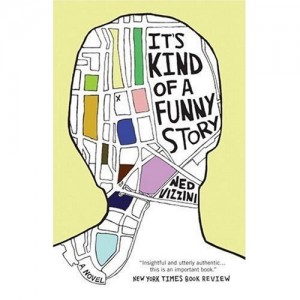 So I finally finished Mockingjay, and started this month’s Book Club selection, It’s Kind of a Funny Story. I’ve made it through the first 10 chapters, so the plot is still unfolding, but I’ve been able to meet and form a bit of an opinion about the book’s protagonist, Craig.
So I finally finished Mockingjay, and started this month’s Book Club selection, It’s Kind of a Funny Story. I’ve made it through the first 10 chapters, so the plot is still unfolding, but I’ve been able to meet and form a bit of an opinion about the book’s protagonist, Craig.
Ned Vizzini, through his keen use of small, quirky but not cloying details, has created a realistic picture of the claustrophobic anxiety that Craig is experiencing during his first year at Manhattan’s Executive Pre-Professional High School. The scenes early in the novel of Craig hiding out in the bathroom at his friends’ houses, and his rationalization why, should ring true to anyone who sought a moment of private refuge in a socially nerve-wracking situation. The rituals and safety points that Craig seeks out in the bathroom foreshadow to the reader that he is a kid who is increasingly in emotional trouble. Likewise, the flashback scene of him as a child, trying to copy a map of Manhattan while hiding under a table, also quietly points to trouble. Young Craig grows increasingly frustrated as he tries, and fails, to perfectly copy the jagged contours of Manhattan island. The scene is quietly heartbreaking, as the reader recognizes the signs of a compulsive obsession with perfection, as none of his copied maps meet his unrealistically exacting standards. Luckily, Craig’s mother rescues her son from despair by suggesting that he create his own maps, thus sparking a lifelong hobby of Craig’s: endlessly doodling and drawing imaginary maps to imaginary towns and cities. The cover art is based on a the type of creations Craig likes to draw.
What’s refreshing about this book, and it’s portrayal of a teenager, is that Craig’s struggle with depression is so subtly evoked. He’s not awash in teen drama; he quietly, embarrassingly tries to cope with his feelings and his anxieties, while still trying to be a good student and a good kid. We’re spared the purple prose and unbearable snark that seem to characterize many teen protagonists in YA books. In writing this way, Vizzini creates a character that the reader does sympathize with, and wants to see recover and be well.
Another relatively original depiction is that of Craig’s parents. The Gilners are not the stock “parents just don;t understand” villains that are lazily dropped into some YA books, movies, and television series. Craig’s parents seem to be decent, loving, understandably concerned parents who try to help their son in any way that they can. The scene in Chapter 6, at the dinner table, illustrates this. Craig’s mom makes all of Craig’s favorite foods, in an effort to make things more”homey.” His folks ask how his therapy is going, and quickly offer to change therapists if Craig doens’ like his current doctor, Dr. Minerva. They try to keep their son’s spirits up, and keep up a normal front, but Craig still cannot keep his dinner down, and his anxious stomach rebels yet again. Vizzini again realistically creates recognizable characters, in this case, it’s two parents who want to help their son, but don’t know how.
What do you guys think? Comments?



















I agree that the character of Craig makes It’s Kind of a Funny Story such a compelling read. I feel like I know, or have known, someone very much like Craig. I love that he isn’t your typical angsty teen from a broken home, but rather is a complex kid from a loving family with dreams and aspirations– and is depressed anyway. I like sharing Craig’s realizations and epiphanies (from the small ones, like when he is at Aaron’s house and realizes that he doesn’t want to “settle” for Nia’s friend, or when he realizes that the police officer in the ER is there to protect him from himself, to the larger epiphanies he has about love and his purpose in life when he is leaving the psych ward).
I also found the male perspective refreshing. I know the way teenage girls think– after all, I was a teenage girl once upon a tim– but it’s interesting to read about the inner turmoil and insecurities that teenage boys struggle with, too.
I like Craig and I rooted for him as I was reading. I cringed when he made mistakes (some pretty huge ones) and cheered his successes. Kudos to Ned Vizzini for creating such an endearing character.